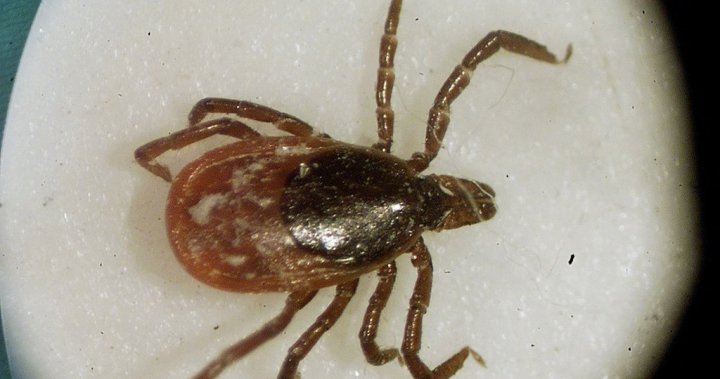Climate change driving rise in tick-borne illnesses such as Lyme disease

A warming climate is driving a rise in Lyme disease and the introduction of lesser-known tick-borne diseases, public health specialists say.
“Climate change in Canada is happening at a much more accelerated rate than we see in parts of the rest of the world,” said Heather Coatsworth, chief of field studies at the National Microbiology Laboratory in Winnipeg.
“Ticks, which are eight-legged organisms, but general bugs, all require a certain amount of heat and humidity to complete their life cycle,” she said.

Ontario, Quebec and Nova Scotia continue to be the hot spots for blacklegged ticks, which can carry bacteria, parasites and viruses that cause disease in humans — but the changing climate is allowing the tick population to grow in other parts of the country, including Manitoba, Saskatchewan, Alberta and British Columbia, Coatsworth said.
Janet Sperling, a scientist who specializes in bugs and the president of the Canadian Lyme Disease Foundation, said that means increased awareness of tick-borne illnesses is needed not only among the public, but among primary-care providers and infectious disease specialists.
“A lot of doctors have been told — this was their training — ‘you can’t get Lyme disease in Alberta; if you don’t have a travel history don’t worry about it,’” said Sperling, who lives in Edmonton.
“There’s no doubt that it has changed and the education hasn’t caught up with some of the doctors,” she said.
The rise in tick-borne disease doesn’t mean you should stay inside, experts agree. But you can protect yourself. Here’s what to know about the illnesses and how to safely enjoy the summer weather.
How common is Lyme disease?
Lyme disease has been on the rise in Canada and the United States for several years. When provincial public health units started monitoring it in 2009, they reported 144 cases across the country. The preliminary case count for 2024 is 5,239, according to the Public Health Agency of Canada.
The real number is likely higher because many people may have had very general symptoms and never got a diagnosis, Coatsworth said.
“There’s estimates that if things keep going the way they are and climate change keeps going the way things go, that in 25 years we’d have about half a million cases of Lyme disease here in Canada,” she said.
What are the symptoms of Lyme disease?
Lyme disease can feel like many other illnesses and may bring on fever, chills, fatigue, headache, swollen lymph nodes and/or muscle and joint aches.
One telltale sign of Lyme disease is a rash that looks like a bull’s eye, a target or that is circular or oval-shaped.
But Coatsworth cautions that about 30 per cent of people who are infected never get a rash, so a Lyme disease diagnosis shouldn’t be ruled out if people have other symptoms.

What are some other tick-borne diseases?

Get weekly health news
Receive the latest medical news and health information delivered to you every Sunday.
In the last couple of years, some provinces have started monitoring three other diseases spread by blacklegged ticks: anaplasmosis, babesiosis and Powassan virus.
Of those, anaplasmosis — although still rare — seems to be growing the fastest, said Coatsworth: “It’s kind of the new kid on the block.”
When public health officials first started monitoring it around 2012, there were about 10 to 50 cases per year in Canada.
There were more than 700 cases of anaplasmosis reported last year, Coatsworth said.
“It’s really picking up speed within the population.”
The symptoms of anaplasmosis can be similar to Lyme disease, without a rash. They can also include cough, diarrhea, abdominal pain and vomiting, according to the Public Health Agency of Canada.
Babesiosis can also cause similar symptoms to Lyme disease without a rash, but it often causes anemia as well, Coatsworth said.
Powassan virus can cause fever, chills, headache, vomiting and general weakness but it often progresses to serious neurological symptoms, such as encephalitis (brain swelling) and meningitis.
Can these diseases be treated?
Lyme disease and anaplasmosis are both caused by bacteria and can be treated with antibiotics, usually starting with doxycycline, said Coatsworth.
Babesiosis is caused by a parasite and is similar to malaria, she said. It can be treated with anti-parasitic medications.
There is no treatment for Powassan virus. Patients are treated with supportive care, which can include intravenous fluids, medications to reduce brain swelling and respiratory assistance.

What kind of ticks carry these dieases?
Two types of blacklegged ticks carry these diseases: Ixodes scapularis, also called a deer tick, is found in several parts of Canada, especially Ontario, Quebec and Nova Scotia. In parts of British Columbia, the dominant tick is Ixodes pacificus, also known as the western blacklegged tick.
Ticks feed on the blood of deer, mice, rabbits and other mammals, as well as birds and reptiles. Birds can carry the ticks long distances, so they can be transported to different parts of Canada. The ticks get infected if the host animal is infected, and they in turn transmit the disease to humans when they bite them and latch on.
What do the ticks look like?
“A lot of people are very surprised when I show them a blacklegged tick. They can’t believe how small they are,” said Dr. Curtis Russell, a vector-borne disease specialist at Public Health Ontario.
An adult tick that isn’t full of blood is about the size of a sesame seed. A younger tick is about the size of a poppyseed.
Where are the ticks found?
Ticks are found in wooded and grassy areas, according to the Public Health Agency of Canada.
That includes forests, parks and hiking trails, but ticks can also live in more populated areas, Coatsworth said.
“(It’s) a lot about the animals that exist in those environments. So a lot of those are peri-urban spaces … kind of those in-between spaces that now have become just maybe your local neighbourhood park where there’s a lot more squirrels. Small rodents and white-tailed deer, especially, have really contributed to sustaining the populations of ticks.”
How do I prevent tick bites?
Preventing tick bites is similar to repelling mosquitoes, said Dr. Mayank Singal, a public health physician with the BC Centre for Disease Control.
Wearing long sleeves, long pants and using bug spray are all important measures. Choosing light-coloured clothing is best because it’s easier to spot a tick when it lands.
Singal also encourages “trying to not come in contact with foliage and bushes, because that’s typically how they will latch on.”
Russell said that means when hiking, stay in the middle of the trail.
After outdoor activities, do a full-body tick check, including parts of the body that weren’t exposed. Russell suggested taking a bath or a shower.
“You can check all your areas where the ticks might have been and if they haven’t bit you yet … they can maybe wash off,” Russell said.
“They usually crawl around … before they bite and they usually tend to bite your hairline, your armpits, the back of your legs, your groin area.”
Russell also recommends washing your clothes and putting them in the dryer, where the high heat will kill ticks.

If I find a tick, should I remove it?
Yes. Do it with tweezers as soon as possible, experts agree.
A tick will embed its mouth in the skin as with the legs sticking out and it’s important to remove the whole tick.
“You want to grab it as close to the skin edge as possible, squeeze the tweezers … and grab the tick and then pull it straight up,” said Singal.
“We don’t want to twist, we don’t want to go left and right. Just pull it straight up so that we get all of it out as much as possible.”
It generally takes about 24 hours for the tick to transmit Lyme disease, anaplasmosis or babesiosis while it’s latched on.
Powassan virus can be transmitted as quickly as 15 minutes after attachment, but very few ticks currently carry the virus, according to the Public Health Agency of Canada.

Then what?
People can take a photo of the tick and submit it to etick.ca, along with information about where you were when you think it bit you. The service, run by several universities and public health agencies, will tell you what kind of tick it is and how much tick-borne disease risk there is in the area.
If you had a tick on you and begin to develop any symptoms, see your health-care provider and let them know you were possibly exposed to tick-borne illness, Russell said.
This report by The Canadian Press was first published June 28, 2025.
Canadian Press health coverage receives support through a partnership with the Canadian Medical Association. CP is solely responsible for this content.


Spirits maker Diageo will cease operations at its bottling facility in Amherstburg, Ont., early next year, as it shifts some bottling volume to the U.S., the company announced on Thursday.
The facility, which bottles Crown Royal products, will close in February in a move aimed at improving its North American supply chain.

Get breaking National news
For news impacting Canada and around the world, sign up for breaking news alerts delivered directly to you when they happen.
About 200 jobs will be affected.
“This was a difficult decision, but one that is crucial to improving the efficiency and resiliency of our supply chain network,” Marsha McIntosh, Diageo’s president of North America supply, said in a statement.
Diageo said it will engage with the community and find ways to support its employees through the transition, and work alongside Unifor to assist unionized workers.
The company said it will still maintain a “significant” footprint in Canada — including its headquarters and warehouse operations in the Greater Toronto Area, and bottling and distillation facilities in Manitoba and Quebec.
McIntosh added the company’s Crown Royal products will continue to be mashed, distilled and aged at its Canadian facilities.
© 2025 The Canadian Press

Toronto police say a 33-year-old man has been charged with attempted murder after allegedly striking two men with his car Wednesday evening.
Officers say they responded to reports of a collision in the area of Don Mills Road and Gateway Boulevard in the city’s North York neighbourhood just before 10:30 p.m.

Get daily National news
Get the day’s top news, political, economic, and current affairs headlines, delivered to your inbox once a day.
Police say two men got into an argument, leading to one man getting into his car and hitting the other man with it.
They say the man then put his car into reverse, striking a second man.
A man in his 50s was transported to hospital with serious injuries and the second man, in his 20s, had minor injuries.
Police say the suspect from Markham, Ont., faces several other charges as well, including two counts of assault with a weapon, uttering threats and dangerous driving.
© 2025 The Canadian Press

A court document shows a Lindsay, Ont., man facing charges for allegedly breaking into an apartment was carrying a crossbow when he was confronted by a tenant.
The resident, Jeremy David McDonald, is also facing assault charges in the incident on Aug. 18 — a fact that has generated widespread interest in the case.
Police information filed in court alleges that Michael Kyle Breen damaged a window and screen at McDonald’s home and carried a crossbow.
The court document says the 41-year-old Breen is charged with break and enter, possession of a weapon for a dangerous purpose, mischief under $5,000 and failing to comply with a probation order.

Get daily National news
Get the day’s top news, political, economic, and current affairs headlines, delivered to your inbox once a day.
Police have said that Breen, who is scheduled to appear in court for a bail hearing next week, was already wanted for unrelated offences.
McDonald, the 44-year-old resident, was charged with aggravated assault and assault with a weapon after he allegedly “did endanger the life” of Breen.
Premier Doug Ford blasted the decision to charge the apartment resident, saying last week that it shows “something is broken.”
Kawartha Lakes Police Chief Kirk Robertson wrote in a statement Wednesday that he recognizes the incident has generated significant public interest and “emotional” responses, but called some of the reaction “unjust and inaccurate.”
Robertson wrote that individuals have the right to defend themselves and their property, but the law requires that any defensive action be proportionate to the threat faced.
“This means that while homeowners do have the right to protect themselves and their property, the use of force must be reasonable given the circumstances,” he wrote.
© 2025 The Canadian Press
-

 Uncategorized3 months ago
Uncategorized3 months agoShop Proud, Eat Proud, Be Proud — Ottawa Canada Day Market This June 28th
-

 3 months ago
3 months agoCanada’s world junior trial saw juries tossed, intense testimony. Here’s a recap
-

 2 months ago
2 months agoRing of Fire road to bring prosperity to First Nation, problems for caribou: report
-

 3 months ago
3 months agoMeasles circulating in northeastern B.C. community, health officials warn
-

 3 months ago
3 months agoAnishinabek Nation chief says he briefed Ontario police on protests against Bill 5
-

 2 months ago
2 months agoFormer major leaguer, Jays doctor Ron Taylor dies
-

 2 months ago
2 months agoJagmeet Singh apologizes for attending Kendrick Lamar concert after Drake calls him out
-

 2 months ago
2 months agoDreaming of a lakeside cottage but can’t afford it? Co-ownership could open that door







